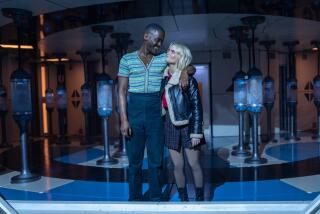Television Review: ‘Doctor Who’
- Share via
The Doctor is (back) in. The second season of the adventures of the 11th Doctor — which is also, officially, the sixth series of the post-16-year-TV-hiatus 21st-century “Doctor Who,” if you don’t count a year of “specials” — begins Saturday on BBC America, with an emphasis on the “America.”
It has been a while — whatever “a while” means in the curlicue chronologies of this time-twisting show — since the Doctor (Matt Smith) has run with recent and future traveling companions Amy (Karen Gillan) and Rory (Arthur Darvill), now newlyweds. But they have been getting messages from him out of the deep past: the Doctor naked in a Baroque painting, cavorting in a fez in a Laurel and Hardy film. And then comes an actual invitation (in a “Tardis blue” envelope, Amy observes, the Tardis being his police-box shaped time machine) and before you can say “John Ford,” we have decamped to America and Monument Valley, where the Doctor awaits, in a cowboy hat. “I wear a Stetson now. Stetsons are cool,” he says, the truth of the second statement being predicated, to his mind, upon the first.
Dr. River Song (Alex Kingston) is there too; she first appeared back when the Doctor still wore David Tennant’s face, invented by present show runner Steven Moffat for previous show runner Russell T. Davies. She and the doctor have a past, in his unremembered future — she calls him “sweetie” — the untangling of which will surely occupy more of this immediately exciting new season.
“I’ve been running, faster than I’ve ever run,” the Doctor says, “and I’ve been running my whole life. Now it’s time for me to stop. And tonight I’m going to need you all with me.” So they go on a picnic by a lake, almost a double date. What follows will involve the moon landing, Richard Nixon, a cashiered FBI agent (Mark Sheppard, whose character argues for return engagements), Area 51, an “X-Files” homage and a “Dracula” reference, and “the silence,” heard of but not seen in last season’s two-part finale, a kind of conceptual cousin to Moffat’s popular Weeping Angels. Clues are cast, seeds are sown, doors are opened that will not be closed at least until season’s end.
One year in, Matt Smith is screwed into this role good and tight. Like many a mythological figure, his Doctor is an ancient child, an unstable mix of authority and impulsiveness. “I’m being extremely clever up here, and there’s no one to stand around looking impressed,” he says irritably, his three friends having gone off to discuss something he can’t be allowed to know. “What’s the point of having you all?”
What “Doctor Who” gives us, that so much science fiction does not nowadays with its pathological analysis of heroism, are romantic mad adventurers, not without their moments of doubt and pain but having a good time in between: The series conducts its serious business with a good deal of comedy. (These opening episodes are very funny, even by local standards.) That’s not to say the darkness doesn’t get in, within and without them; indeed, stories have gone repeatedly to the brink of nothingness — the extermination of the Earth, the unweaving of reality.
Alluding to something the Doctor is up to, River says, “It could rip a hole in the universe.”
“Yes, but he’s done it before,” protests Amy.
“And in fairness,” Rory points out, “the universe did blow up.”
But it turned out all right! It always does.
Doctor Who infobox 4/23/11
‘Doctor Who’
Where: BBC America
When: 6 and 9 p.m. Saturday
Rating: TV-PG (may be unsuitable for young children)
More to Read
The biggest entertainment stories
Get our big stories about Hollywood, film, television, music, arts, culture and more right in your inbox as soon as they publish.
You may occasionally receive promotional content from the Los Angeles Times.











